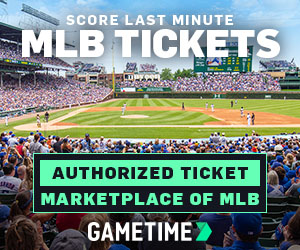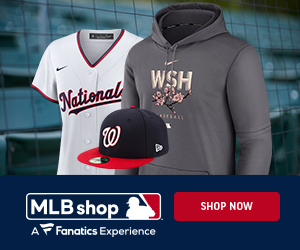Best Ways To Get To Nationals Park | Washington DC
Posted by Kurt Smith
Hello Baseball Fans! I’m here to help you with all of the best ways to get to Nationals Park in Washington D.C., at least if you’re not driving, which you shouldn’t.
I promise I’ll cover driving and parking when I can (use SpotHero to book your parking if you must), but this post contains lots of info on your alternatives, especially public transportation…which is almost always the best way.
(Note: this article contains affiliate links. If you use an affiliate link to make a purchase, Ballpark E-Guides earns a commission, at no extra cost to you. Thanks for your support!)
I’ve broken your routes down so you can skip to what you want to know:
From Metro D.C.: Using Metro Rail / WMATA To Nationals Park
Parking at Metro Stations
From Inside D.C., Part 2: Metrobus
From Suburbs (On Weekdays): VRE / MARC
From Other Cities: Amtrak, Megabus
For A Day in The Capital: D.C. Circulator
Something Different: D.C. Pedicabs
Green and Healthy: By Bicycle
Capital Bikeshare
Taxicab / Rideshare
So here we go, after a quick word from our friends at Gametime:
Gametime has your cheap Nationals tickets…with a lowest price guarantee, panoramic seat view photos, and great last minute deals…even after the game starts!
(See why Ballpark E-Guides loves Gametime here!)

Thankfully, Metro is no longer using “Unsafetrack”!
The Best Way To Get To Nationals Park: WMATA. The Washington Metropolitan Area Transportation Authority, known almost exclusively here as the “Metro”, operates an efficient and reliable network of trains and buses that gets high marks for being clean, safe and easy to use. Metrorail is particularly nice if you’re staying in the city within walking distance to a station, and it’s the favorite choice of Nationals fans.
If trains aren’t running for whatever reason, free (but slower) buses are provided.
Riding WMATA requires a “SmarTrip” card, which you add value onto and use to pay for each ride and for parking. Definitely make sure you have enough value on your card after the game.
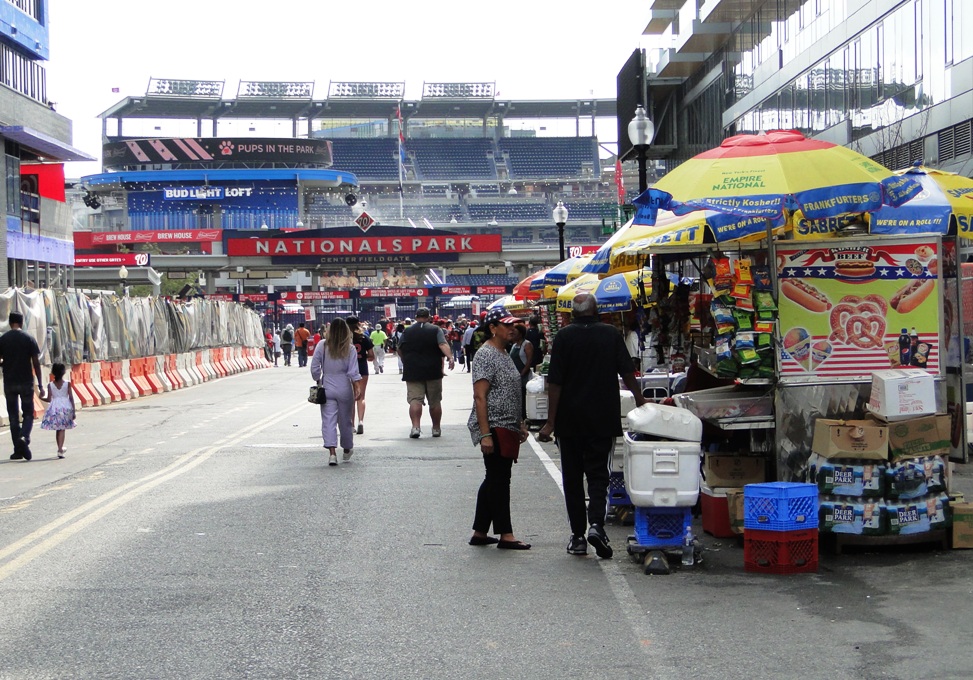
Setting up a hot dog stand on the way to the ballpark from the train station. It’s…it’s…genious!
Tip #1) Metrorail. The Navy Yard-Ballpark Metrorail Station on the Green Line drops riders off at M and Half Street, a block from the center field gate. This stop can handle up to 24,000 riders per hour, so crowds don’t usually delay things for long. From the station, it is a short walk past inexpensive chili dogs, water bottles, souvenir vendors and a beer garden to easily Nats Park’s most visually appealing entrance.
You can transfer to the Green Line for free from other lines at several locations. Transfer stations can be busy on game days. If you transfer from the Red Line, don’t stay too late. The last Green Line train does not transfer to the Red Line.
With multiple transfer locations, there’s no reason why you can’t skip the first stop and use the next one. If you’re getting on the Yellow Line southbound after the game, for example, you can go one stop past L’Enfant to Archives and transfer there. You’ll have better luck finding a seat before the large L’Enfant crowd gets on.
From the furthest stations, it’s usually less than an hour to the Navy Yard-Ballpark station. You’d do well to load value on your SmarTrip card beforehand, so you aren’t ferociously trying to make change with a bunch of patrons waiting behind you at the crowded ballpark station.
If you want to avoid Green Line game crowds, you can exit from Capitol South on the Blue/Orange lines and walk just under a mile from there. Or you can use the Red to Union Station and ride the D.C. Circulator (more on that in a bit). The Nats also suggest exiting the Blue/Orange Line at the Eastern Market Station and passing by a lot of restaurants, but this is a mile walk (uphill, both ways), so be sure you’re up for it.

Remember, approximately 30,000 of these people will be using the same method of transit as you are. Pay attention…
Here’s a key tip from WMATA’s website: during peak hours (which can include game nights), some Green Line trains run just two minutes apart. You can look at the message signs on the train platform and see if you only have a two minute wait for a less crowded train, and a better chance of landing a seat. Also, the last two cars on the train are usually the least crowded.
Crowds for the train start to thin out not long after the game ends, so you can spend 15-20 minutes buying a souvenir or two on Half Street. You can also use the far station entrance, just make a right turn on M Street and walk a couple of blocks east to the entrance just before New Jersey Avenue. It’s a longer walk, but you’ll get to the platform a little easier and avoid the masses.
Or scrap that and get on at Waterfront Station, about 3/4 of a mile away on M Street. The platforms aren’t any less crowded, but you pass by some fine eateries on the way.
In most cases, the last trains leave late enough that after the game you should have no problem. On weekends the last train leaves after 2:00 AM. But there have been complaints about the lack of service after, say, a rain-delayed game, so have a backup plan just in case. It may require an Uber or Lyft, which obviously wouldn’t be cheap.
On Sundays the last train leaves at 10:52 PM, so I would recommend a different route to get there for Sunday night games.
Important note if you’re heading to Greenbelt after the game (as Baltimore area fans probably would be): check the destination on the front of the train, because if it’s Mount Vernon Square you may have to get off and hop on another train to Greenbelt. Not a big deal, but it can be confusing.

Don’t be fooled by that fire hydrant there. This lot is legit. I’m almost sure.
Tip #2) Parking at Metro Stations. Metrorail’s tentacles have a long reach in Maryland and Virginia. On the outer reaches of most rail lines (near the I-95/495 Beltway) are ample park-and-ride stations. Parking lots are inexpensive compared to ballpark parking garages, and they’re free on weekends. The lots fill up on weekdays with commuters, so you’d do well to seek out the less popular stations unless you don’t mind a walk.
The WMATA website informs you how much it costs to park at each station (the Nationals list the stations on their website, but not parking prices).
You need to use your SmarTrip card to pay your way out of the lot. If you don’t have sufficient fare, there are Exitfare machines inside the station to add funding. Many stations have started accepting credit cards for parking, but not all of them, so be prepared.

The only venue in sports whose name changes less frequently than the home team’s.
One important note: should you use the Largo Town Center park and ride, be sure that there is not an event at nearby FedEx Field, which applies an “event parking” rate that you definitely won’t want to pay. You’ll also probably get towed if you try parking at the nearby mall. There are adequate nearby park-and-rides, like at New Carrollton Station, that are not far out of the way.
You might be able to find what the city deems “normal demand parking” near a station, where meters are $.75 an hour until 6:30 PM. The high demand parking is enforced until 10:00, so that wouldn’t be worth it.
The aptly named Anacostia Station just across the Anacostia River is not far at all from the ballpark, and has very cheap all day parking, but I’ve read some stories about this station not being in the greatest of areas. Maybe for a day game it would be okay and a good money saver (and not a bad walk on a nice day), but keep your eyes open if you try this one.
Never Drive To Nationals Park Without A Plan…
Book Your Parking Spot NOW With My Friends at SpotHero!
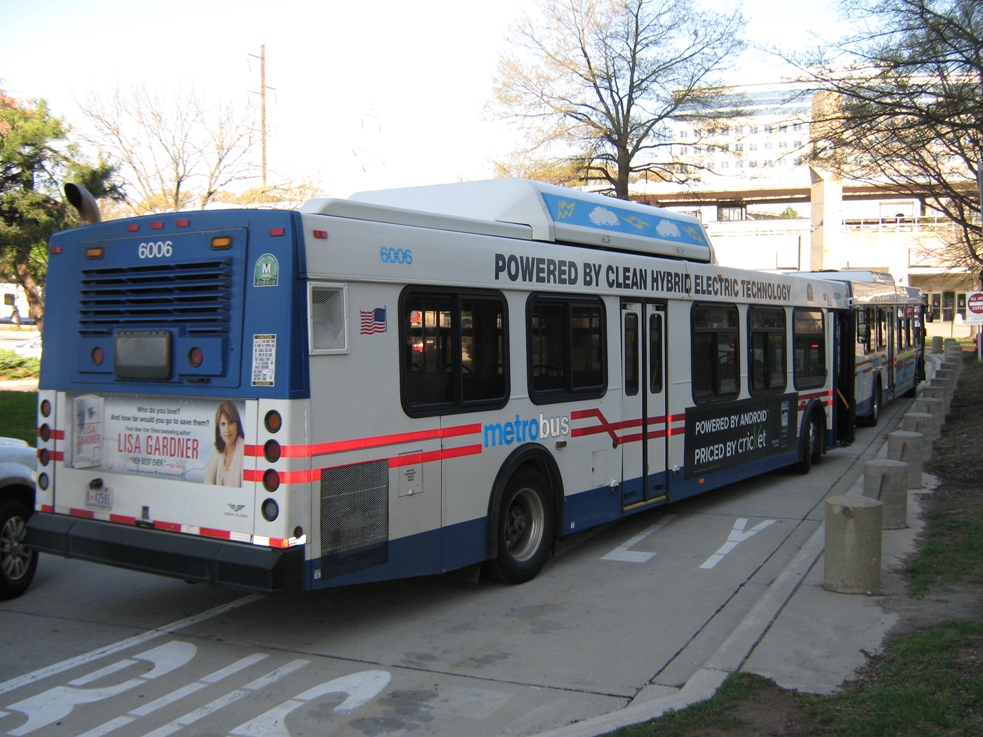
Powered by clean hybrid technology, and of course, your Nats fandom!
Tip #3) Metrobus. Baseball fans don’t use Metrobus as much as the rail system, so they’re less crowded; unfortunately they are subject to the same traffic laws as the rest of us and can be a slow ride. Nice view of the city though.
The Metro website lists a number of bus routes as having stops at Nationals Park. Many routes pass near Nationals Park (or the Navy Yard, which isn’t far), and you can use them to get to a Metro stop or a parking area. Check the schedule of any route you plan to use and be sure that they will be available after the game. Most run until a little bit past midnight; a few have late night service.
You can jump on the N22 bus from the Red Line at Union Station, and use it to return to Union, saving yourself a transfer and the crowds on the Green Line. If you don’t have a SmarTrip card or pass, you will need exact change.

Yep, you can do the double after an Orioles game! (You need another route back though.)
Tip #4) VRE/MARC. The Virginia Railway Express and Maryland Area Regional Commuter lines offer transit from Virginia and Maryland suburbs. These lines are for commuters, so you would only be able to use them for weekday games. But they are an inexpensive and very easy way to get to D.C. from further away points like Fredericksburg and Baltimore. Could be a great choice for Opening Day.
Both MARC and VRE trains stop at Union Station, from which you can use a Red-Green ride to get to the game (or a Blue/Orange train to Capital South); The Manassas VRE line stops at L’Enfant Plaza, a short Green Line ride away from the ballpark. If you don’t want the additional transfer after the MARC trip, the Camden Line from Baltimore stops at the Greenbelt station, and you can use the Green Line from there.
Again, this is only good for weekday games, but they’re great for that. To get from Camden Station in Baltimore to Greenbelt for under $10 one way can’t be beat. And most stations have free parking.

As you can see, New Carrollton Station’s got you covered for trains.
Tip #5) Amtrak/Megabus. If you’re coming from out of town on an Amtrak train, there are plenty of points from which you can hop on a Metro train: New Carrollton Station on the Orange line; Rockville and Union Station on the Red line; and King Street Station on the Blue/Yellow line. From there it’s a two-train ride (see Metrorail) with a free transfer to Nats Park.
Megabus is a great low cost service that you can use from another nearby metropolis like Philly or even Atlanta, for as low as $1 if you book it early enough. Nice comfortable buses with wi-fi, and they stop at Union Station as well. From Baltimore, you can hop on at the White Marsh Mall easy peezy.
If you stop at Union Station, you could also hop on a D.C. Circulator bus for a cheap if slower ride to the park with a fine view.
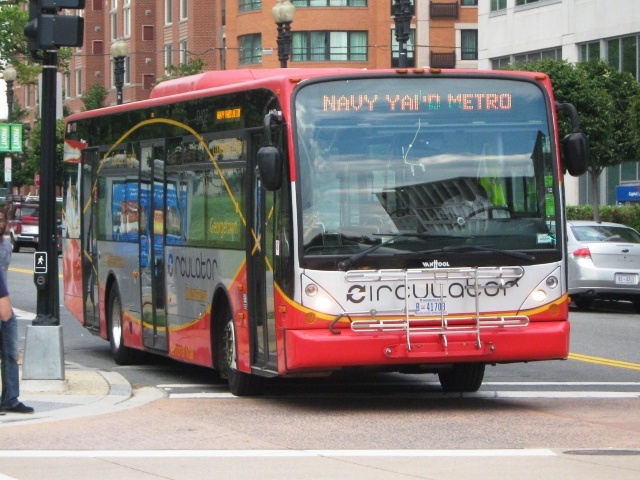
“Thanks, Danny, I love Washington.”
Tip #6) D.C. Circulator. The D.C. Circulator bus is a cheaper way to travel around the city and recommended if you’re making a day around town. There are four separate routes, which take visitors to all of D.C.’s tourist destinations for just a buck per ride. A day pass is just $3. The Circulator drops riders off at the Navy Yard Station entrance.
You can see the National Mall, the White House, the Lincoln Memorial and other sights using the Purple Route, and then transfer to the Blue Route to get to the ballpark. The Blue Route (but only the Blue Route) extends service on game days, running until midnight for night games or about 9:00 PM for day games, including on weekends. It only runs until 10:00 on Sunday nights.
You can use the WMATA SmarTrip card to ride the Circulator. Transfers are free from another Circulator or Metrobus, and very cheap from Metrorail, with a SmarTrip card. Good if you have more than one destination in mind. Again, the Circulator stops at Union Station, if you’re using the Red Line and want to avoid the Green Line crowds.
Circulator buses tend to circle their route every ten minutes or so. You can find out where yours is on their website.
Unfortunately the Potomac Riverboat water taxi to Nats games is no longer running; I’ll update this if I hear otherwise.
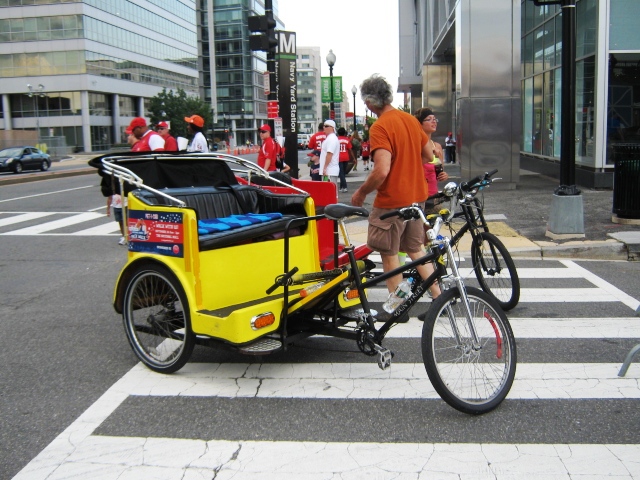
A much better view of the city than from the train, and enough space for your date!
Tip #7) Pedicabs. There are now a few Pedicab companies available to take you to ballgames at Nationals Park. Pedicabs are rickshaws towed by fit cyclists; they generally take you wherever you need to go while avoiding traffic hassles, pointing out tourist sites and engaging you in friendly conversation. It’s a neat way to get around the nation’s capital without fuming at the gridlock.
There used to be several pedicab services that were free, and cyclists lived on tips, but nowadays they mostly offer fairly expensive tours of the city, and I’m not sure what they’ll do for baseball fans. There are sometimes cyclists available at the center field entrance or on New Jersey Avenue after games.
Don’t wait till you get to the ballpark to get your Washington Nationals gear…
Order your caps, jerseys, and more now at MLBShop.com and save!Click here to order your Nationals gear today!
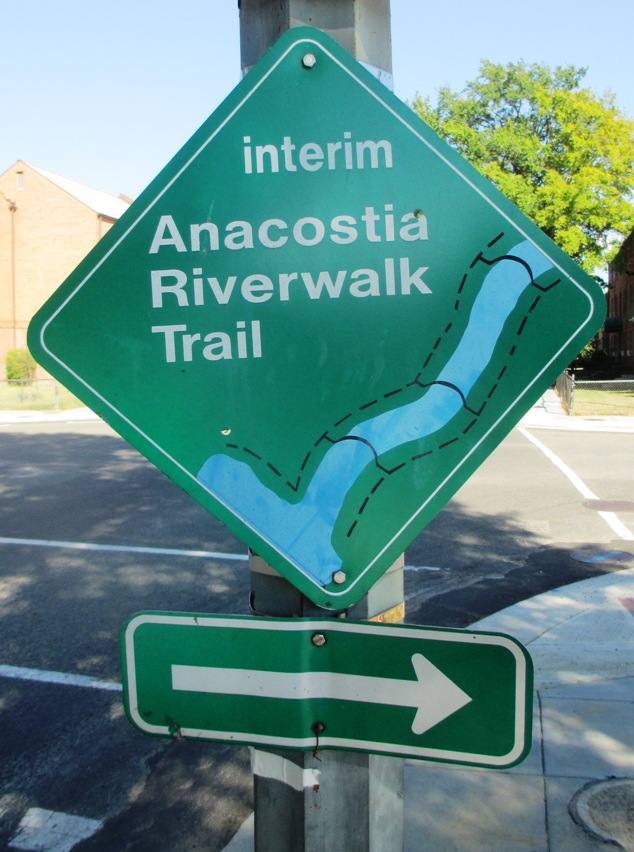
If you can find the Anacostia River, you can find Nationals Park.
Tip #8) Bicycle. Should you two-wheel it to Nationals Park yourself, the Nationals actually have a bicycle valet in the Red Garage C, the ballpark garage on the corner of N and 1st Street. It starts two hours before game time and closes one hour after the last pitch. There are also plenty of bike racks outside to lock up your two-wheeler, if you don’t like the discomfort of feeling the need to tip your valet.
The new 28-mile Anacostia Riverwalk along both banks of the river makes for a swell bike ride, but I have read about some incidents, so just be sure to keep your wits about you. I’m told it’s very cool lit up at night, if you’re comfortable cycling then.
D.C. is a very bicycle-friendly city, with multiple bicycle lanes and trails; you can order a map from DDOT. You can also easily park your bike at most Metrorail stations, especially the outer perimeter ones.
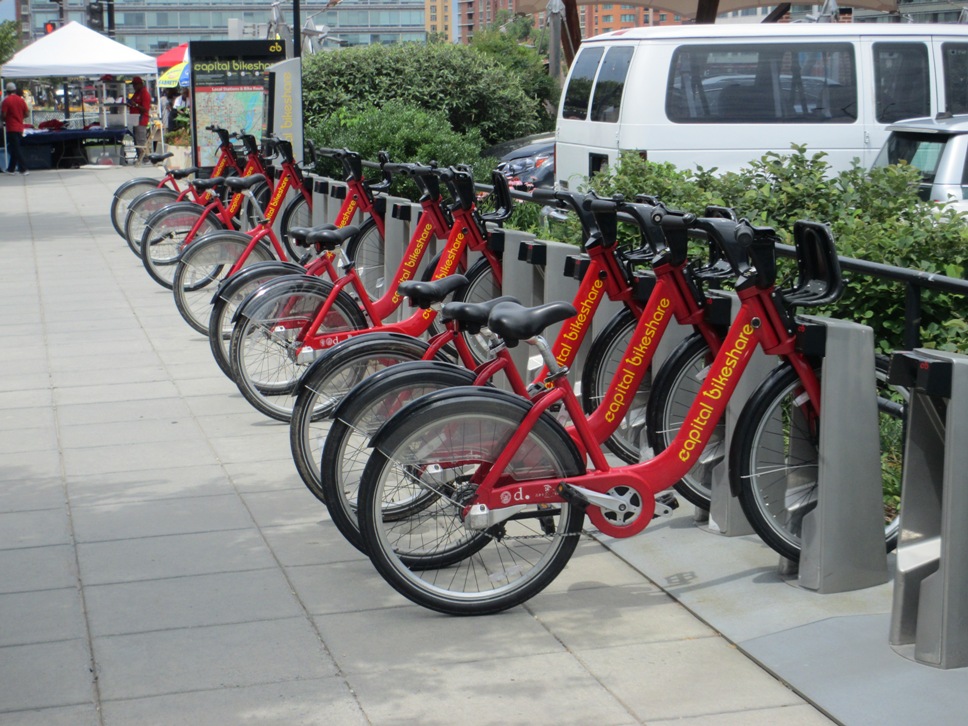
A bicycle valet may be nice, but a rented bike allows for a quick escape!
Tip #9) Capital Bikeshare. Capital Bikeshare is a bicycle rental service that allows members to borrow bicycles from over 700 stations (!) all over D.C. proper, including a station on the east side of the ballpark where you can check it in and lock it. If they are all full, there’s other docks at 1st and K, New Jersey and M, and 3rd and Tingey Streets. You can even cycle from the Alexandria area and over the Williams Bridge.
The first 30 minutes are free if you’re a member (the cost of membership varies by length of membership), so if you hustle you can get a free ride to the ballpark and some great exercise to boot. I’ve read that you can take a Metro to the Eastern Market or Capitol South stations, and use a bike from there instead of standing on the crowded Green Line trains. Nice and less pushy alternative.
There are now a bunch of dockless bikeshare services in D.C, like Lime, Spin (with scooters!) and more…too many to list here. They don’t require finding a docking station, and you can download apps for them that can tell you where a vehicle is available.
You can download the “Transit” app to stay aware of them all.

I’m quite certain this is designed to be confusing.
Tip #10) Taxicab/Rideshare. There is now a specific location for Lyft and Uber pickups, on the west curb of New Jersey Avenue between M and N Street. There’s an additional one on New Jersey at the I-695 overpass. Uber listed Nationals Park as one of their top ten destinations of 2019, so clearly people with the means prefer it to Metro a bit.
Ride sharing and taxis are expensive, especially with post-game traffic and surge pricing. But it might be a little easier and quicker than using the Metro depending on where you’re coming from. If you can get someone to go in with you on the cost, this might work better for you, and you won’t have to worry about service being available after the game…like you sometimes will with Metro.
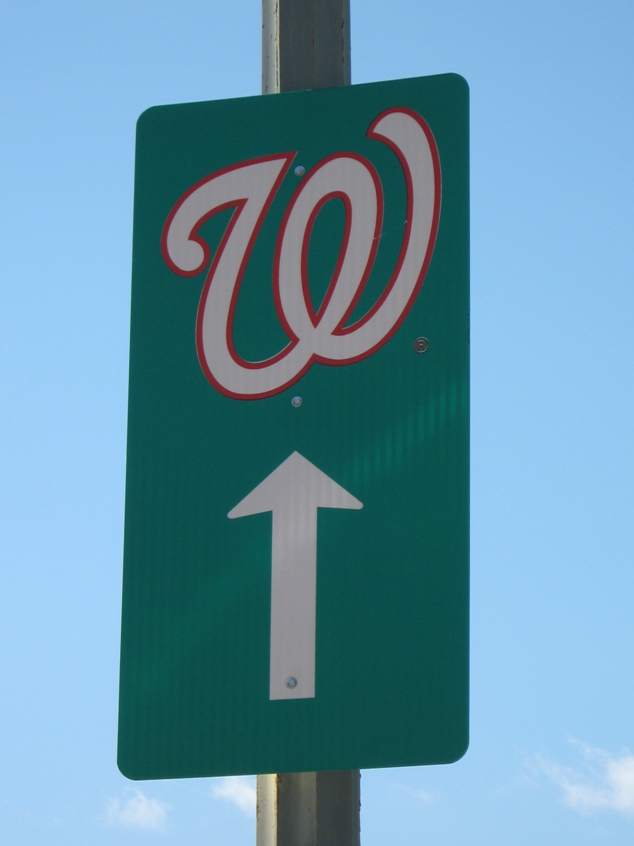
Sure, it would be nice if it were this easy.
Get all that? There you go…making it as easy as possible to get to your next game at the home of the Washington Nationals! If you’d like some parking tips, click here (or just use my friends at SpotHero), but I promise I’ll cover parking in more depth down the road.
Thanks for reading, and please support our sponsors!
(Note: this article contains affiliate links. If you use an affiliate link to make a purchase, Ballpark E-Guides earns a commission, at no extra cost to you. Thanks for your support!)
Want to save money on baseball tickets, parking, gear and everything else?
Check out my Fan Resources Page!!
If you go to baseball games, you’re going to spend money...on tickets, parking, food, and souvenirs, not to mention hotels and travel expenses if you’re going on a baseball road trip.
I’m here to help…click here to see my Fan Resources page, where I share some of my favorite recommendations for buying tickets, booking baseball parking and saving on travel expenses!

